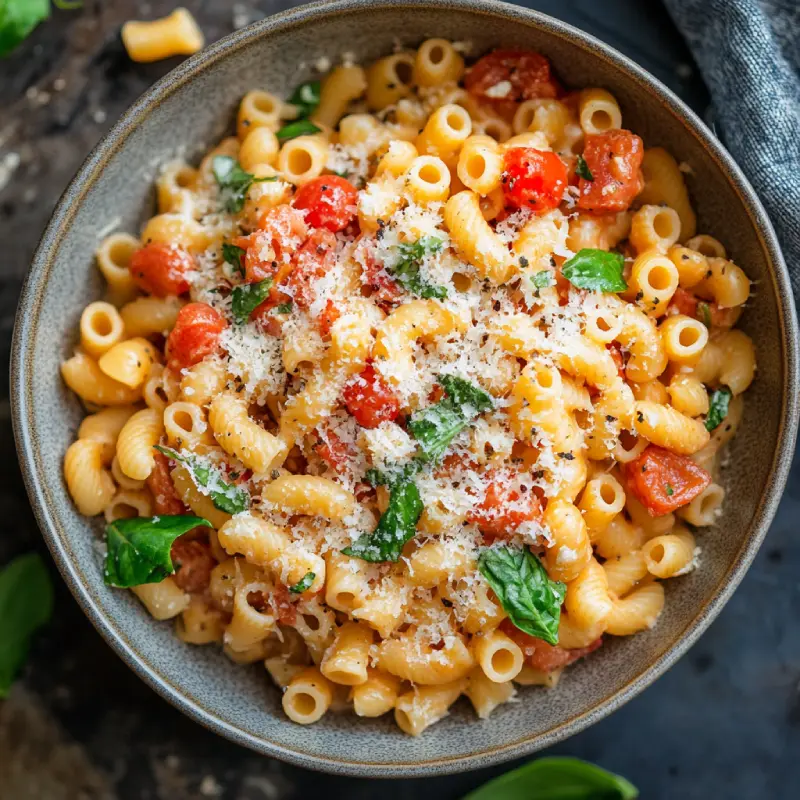Introduction to Ditalini Pasta
Ditalini pasta, characterized by its small tube-like shape, is a staple in many traditional Italian dishes. The name “ditalini” literally translates to “little thimbles” in Italian, reflecting its short, tubular appearance. This pasta is particularly popular in soups and stews where its size allows it to complement rather than overpower other ingredients.
Commonly used in Italian cuisine, ditalini is often featured in recipes like Pasta e Fagioli and Minestrone, blending beautifully with various broths and ingredients due to its petite size and excellent ability to absorb flavors. Beyond Italian dishes, ditalini can be adapted for a range of culinary styles, making it a versatile choice for many chefs and home cooks.
Classic Ditalini Pasta Recipes
Ditalini Pasta with Peas and Parmesan
This simple yet delightful dish combines ditalini pasta with vibrant green peas and a rich Parmesan cheese sauce. It’s a perfect meal for those seeking comfort food that’s easy to prepare yet satisfying. The peas add a fresh, sweet contrast to the creamy and savory notes of the Parmesan sauce.
Baked Ditalini
A heartier option involves baking ditalini pasta with creamy sauces and a variety of cheeses. This baked pasta dish is ideal for family dinners, offering a comforting and filling experience. The baking process allows the flavors to meld beautifully, resulting in a creamy, indulgent dish.
Ditalini with Roasted Tomato Sauce and Goat Cheese
For those who enjoy a more robust flavor profile, this recipe features ditalini paired with a rich roasted tomato sauce and the tangy freshness of goat cheese. The combination of the smoky, deep flavor of the roasted tomatoes with the creamy goat cheese creates a sophisticated dish that’s as pleasing to the palate as it is to the eye.
These ditalini pasta recipes showcase the pasta’s versatility and adaptability to different ingredients and preparation methods, making it a favorite choice for quick weeknight dinners and elaborate gatherings alike. Each recipe brings out a unique aspect of ditalini, from its ability to pair with light vegetables and cheeses to its suitability for rich, hearty sauces.
Advanced Ditalini Recipes
Exploring innovative ways to use ditalini pasta beyond traditional dishes can lead to delightful culinary creations. Here are two unique recipes that showcase the versatility of ditalini in both risotto-style cooking and as a staple in a refreshing salad.
Ditalini Risotto
This recipe takes a creative twist on the classic risotto by substituting rice with ditalini pasta. The result is a dish that retains the creamy, comforting essence of risotto but introduces a unique texture and flavor profile. Cooking ditalini in this manner allows it to absorb flavors more intensely than rice, offering a richer taste experience.
- Ingredients: Include ditalini pasta, chicken or vegetable broth, Parmesan cheese, white wine, and your choice of vegetables like mushrooms or asparagus.
- Cooking Method: Similar to traditional risotto, start by sautéing onions in butter, add the ditalini to toast slightly, then gradually add broth and wine as you stir frequently to achieve a creamy consistency.
- Flavor Profile: The pasta complements the savory notes of Parmesan and the freshness of the vegetables, creating a well-rounded dish.
Mediterranean Ditalini Salad
Transform ditalini pasta into a light and vibrant Mediterranean salad by combining it with classic flavors from the region. This salad is perfect as a side dish or a standalone meal, especially during the warmer months.
- Ingredients: Ditalini pasta, kalamata olives, cherry tomatoes, feta cheese, cucumbers, red onion, and a dressing made from olive oil, lemon juice, garlic, and herbs.
- Preparation: Cook the ditalini until al dente, then mix with chopped vegetables, olives, and crumbled feta. Toss everything with the dressing to marry the flavors.
- Serving Suggestions: Serve chilled or at room temperature, garnished with fresh herbs like parsley or mint for an extra touch of freshness.
Nutritional Information: Benefits of Ingredients in Ditalini Dishes
When crafting dishes with ditalini pasta, incorporating ingredients like peas, tomatoes, and various cheeses not only enhances flavor but also offers several health benefits:
- Peas: These small but mighty legumes are a great source of plant-based protein and fiber, which can aid in digestion and help maintain a healthy weight. Peas are also rich in vitamins A and C, which support the immune system, and iron, which is essential for blood health.
- Tomatoes: Rich in vitamin C, potassium, folate, and vitamin K, tomatoes are known for their heart health benefits. They also contain lycopene, an antioxidant linked to reduced risk of heart disease and cancer.
- Cheeses: Depending on the type used, cheese can be a good source of calcium, vital for bone health. It also provides high-quality proteins and fat, which can be beneficial for muscle repair and energy levels.
Incorporating these ingredients into your ditalini recipes not only makes the dishes delicious but also nutrient-rich, supporting overall health.
FAQs: Cooking, Storing, and Utilizing Ditalini Pasta
Maximizing the culinary potential of ditalini pasta involves mastering its preparation, storage, and creative uses in dishes. Here are some frequently asked questions to help you perfect your pasta skills.
How to Properly Cook Ditalini to Achieve the Perfect Texture
- Boiling: Cook ditalini in a large pot of boiling salted water. To achieve al dente texture, boil the pasta for about 8-10 minutes, checking the firmness periodically.
- Testing: Sample a piece before the cooking time is up to ensure it’s not too soft or too firm.
Proper cooking techniques ensure that ditalini retains its shape and texture, making it ideal for various recipes.
Storage Tips for Cooked Ditalini
- Cooling: Allow cooked ditalini to cool completely before storing to prevent it from becoming mushy.
- Refrigerating: Store in an airtight container and refrigerate. Properly stored, cooked ditalini can last for up to 5 days.
Ideas for Making Ditalini Pasta Salads and Soups
- Pasta Salads: Combine cooled ditalini with fresh vegetables, a protein source like chicken or tuna, and a light dressing for a refreshing salad.
- Soups: Add ditalini to broths or creamy soups in the last minutes of cooking to avoid overcooking the pasta.
Ditalini’s small size and texture make it perfect for soaking up flavors in soups and adding substance to salads.
These FAQs cover essential aspects of working with ditalini pasta, from cooking it just right to storing leftovers and incorporating it into diverse dishes. By following these tips, you can enjoy delicious and perfectly textured ditalini pasta in a variety of meals.
Conclusion: Mastering Ditalini Pasta Dishes
In this guide, we’ve explored the versatile world of ditalini pasta, covering everything from cooking methods to creative recipes that showcase its potential in your culinary repertoire. By understanding the nuances of cooking ditalini perfectly, storing it correctly, and utilizing it in various dishes, you can elevate your meals and impress both family and guests.
- Versatility in Cuisine: Ditalini pasta is not only a staple in traditional Italian dishes but also adaptable for innovative recipes across different cuisines, proving its versatility in the kitchen.
- Culinary Creativity: From hearty soups to refreshing salads, ditalini serves as a perfect base for a variety of flavors and ingredients, allowing you to experiment and personalize your dishes.
Whether you’re a novice cook or a seasoned chef, mastering ditalini pasta provides a foundation for countless delightful and satisfying meals. Continue to explore and experiment with this wonderful pasta type, and always remember the joy that comes from creating delicious food at home.

